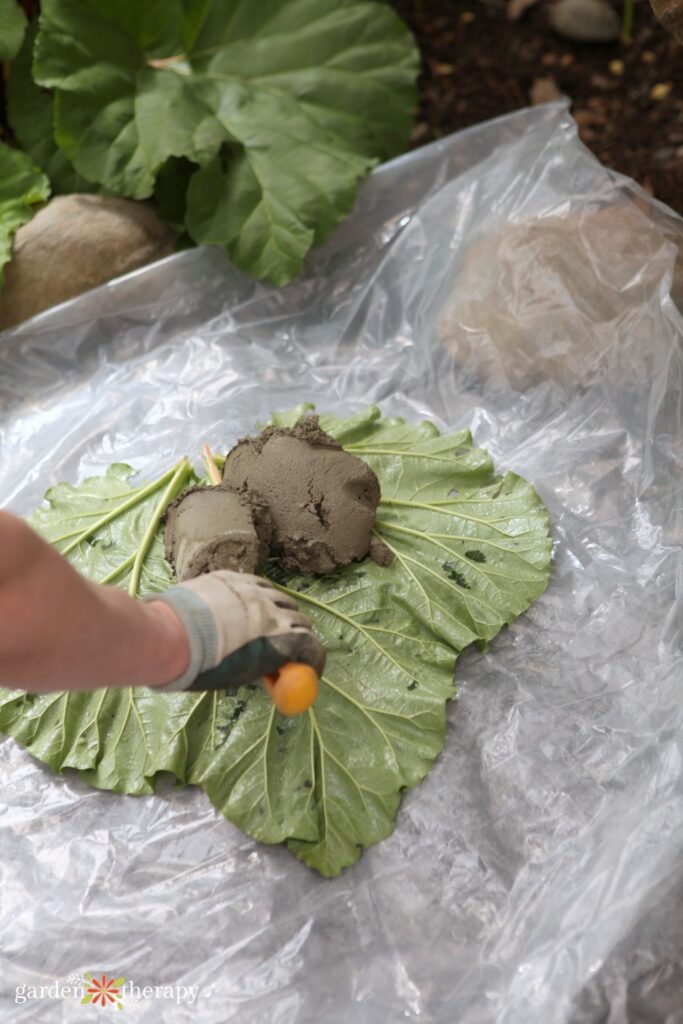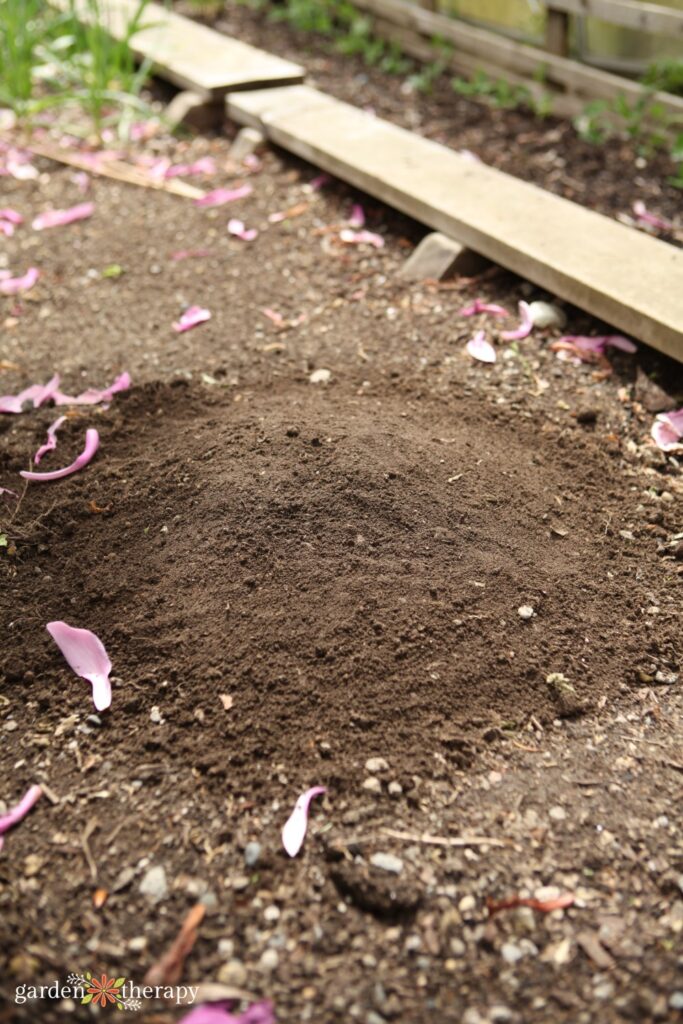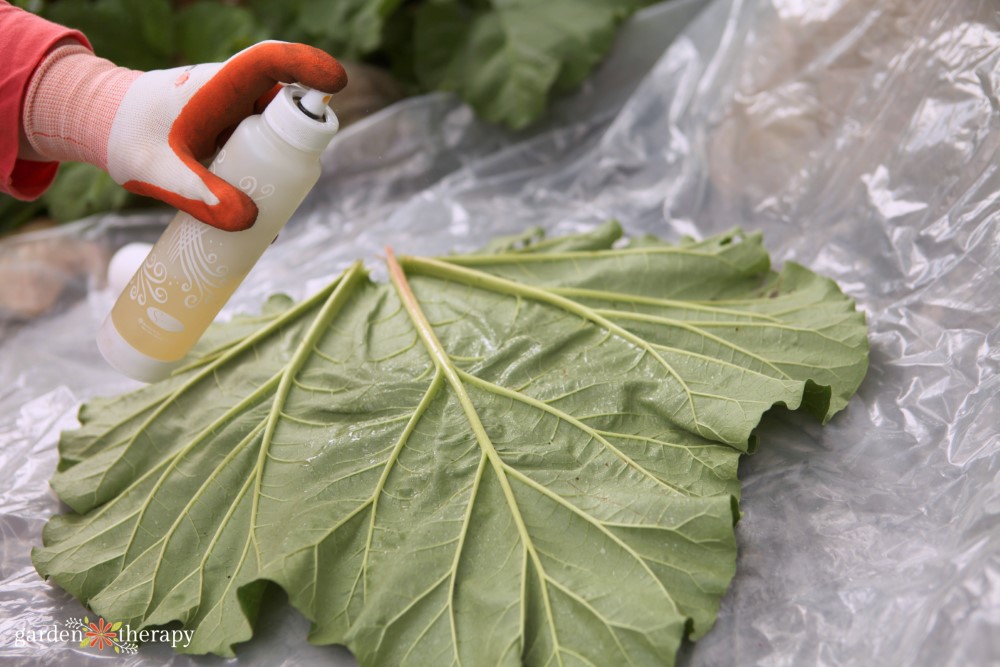Adding a bird bath is one of the best ways to increase the number of songbirds and wildlife in your garden. When set on the ground, birds use it for drinking, bathing, and cooling down. Here’s how to make your own DIY concrete bird bath using a rhubarb leaf!

The first time I tasted a tart rhubarb stalk dipped in sugar, I was hooked! The flavour is surprisingly complex for a stem, and when matched with something sweet, it’s a little slice of heaven.
The leaves, on the other hand, are not so tasty (which is good since they are toxic), but it’s such a pity that this prolific plant doesn’t have more culinary uses.
This DIY concrete bird bath is my attempt to get a little more out of my rhubarb plants. The ruffled and very large leaves make a wonderful mould for a bird bath. Once cast in concrete, these rhubarb leaves will live on forever and supply garden birds with a watering hole.
Here’s how you can make your own concrete leaf bird bath!
- Harvesting Rhubarb
- How to Make a Concrete Leaf Bird Bath
- Materials
- Make It!
- Caring for Your Concrete Bird Bath
- Frequently Asked Questions About Concrete Bird Baths
- Make a Bird-Friendly Backyard

Harvesting Rhubarb
To start this project, you’ll need some big, juicy leaves. We also want to make sure we’re not harming the rhubarb when we pick the leaves.
Let a new plant grow for two years before harvesting any stocks, and only take one-third of the plant in year three and beyond. After that, you can harvest the plant pretty heavily, leaving the smaller stalks behind after six to eight weeks of pulling off stems for pie and bird baths.
Follow the steps in this post to harvest rhubarb properly (you’ll twist, not snip).
For this rhubarb leaf bird bath, choose a firm leaf with a strong shape (if you can find any without holes, then congratulations, you have won the slug war!).
It’s best to start this project at the beginning of the season when the leaves are strongest and less chewed. A few nibbles or holes are expected in an organic garden and won’t take away from the final project.

How to Make a Concrete Leaf Bird Bath
If you’ve never worked with concrete before, this is a great first project to try out. It’s simple but creates a beautiful result that you can display in your garden while helping the local birds.
Materials
- Large rhubarb leaf
- Rubber gloves, protective glasses, and a mask
- Repair concrete (see note)*
- Wheelbarrow or large bucket
- Water source (hose, watering can)
- Old trowel
- Plastic drop cloth
- Vegetable oil or cooking spray
- Stiff bristle brush
- Chisel and hammer (optional)
*Choose a lightweight concrete mix (less gravel) for a smoother finished product. Or, choose a heavier-weight concrete mix (more gravel) if the stones will be in high-traffic areas. The best concrete for small, decorative projects is repair concrete, which has no large pieces of gravel in it.

Make It!
Wear protective gloves, glasses, and a mask, and mix the concrete according to the manufacturer’s instructions.
While the measurements and mixing instructions will be on the package, in general, you will want a large container to mix a whole bag at once. An old wheelbarrow is ideal as the height makes mixing a bit easier.
First, add the concrete to the container, then pour the recommended measure of water into the center. Stir thoroughly and use immediately. The consistency should be on the drier, firmer side. Add more dry mix if it is too runny.

Build a firm mound in the soil in the shape you want your bird bath to take.

Lay the plastic drop cloth over the mound and place the leaf, vein-side up, on it.

Spray the back of the leaf thoroughly with cooking spray or brush with oil.

Pile the concrete onto the leaf and pat it all around to compress the concrete and remove air bubbles. Spread the concrete to just 1/2″ from the edge of the leaf and gently round the extra 1/2″ of the leaf over the edge of the concrete. This will give the edges a more refined look.

Wrap the concrete in plastic and allow it to dry for 12 hours if the outside temperature is hot and dry or 24 hours if it is cooler and more humid.

Gently peel off the leaf before the concrete is set, being mindful that it can easily break or crack at this stage. Generally, it’s preferable to wait until the concrete is completely dry to unmold it, but often, this leaves more plant material behind in the crevices.

Allow the concrete to cure completely according to the package instructions, then use a stiff bristle brush to scrub off any remaining plant material. You may also use a chisel and hammer to remove any concrete that has escaped the confines of the leaf, leaving the bird bath in a finished but still natural shape.
Set the concrete bird bath upright in the garden, on a raised wood stump or atop some overturned clay pots.

Caring for Your Concrete Bird Bath
Your concrete bird bath will handle the sun, the rain, and anything the warm weather can throw its way. But once the cold creeps in, you might want to retire your bird bath for the year.
Concrete is a porous material that is prone to cracking and chipping if not properly maintained. You can’t let water freeze in it, as this will cause small cracks.
Before the winter, drain it and bring it indoors where it is dry. Alternatively, you can drain it and cover it with something like a tarp until the springtime.

Frequently Asked Questions About Concrete Bird Baths
Concrete is safe for birds and one of the most effective ways to make a bird bath. The leaf imprint keeps them beautiful as well as functional for the birds.
Many bird baths you buy have been glazed for appearance and to make them easier to clean. But birds don’t like the glazing, finding it slippery and uncomfortable while trying to use the water.
If your DIY concrete bird bath becomes cracked, you can resurface it. To do this, you will spread a layer of new concrete atop the old one, ensuring it’s moist and clean before applying the new layer of concrete. Apply the layer of concrete, then use a new leaf or two to get a new imprint.
Make a Bird-Friendly Backyard
- DIY Wild Bird Suet Feeder
- Beaded Suncatcher Mobile to Protect Wild Birds
- Attract Nature’s Smallest Flyer With This Hummingbird Food Recipe
- Attract Pretty Pollinators With an Irresistible Butterfly Garden
Rhubarb Leaf Concrete Bird Bath
Equipment
- Safety gear (rubber gloves, face mask, apron, eye protection, etc.)
- Wheelbarrow or large bucket
- Water source
- Old trowel
- Plastic drop cloth
- Stiff bristle brush
- Chisel and hammer (optional)
Supplies
- Large rhubarb leaf
- Repair concrete *see note
- Vegetable oil or cooking spray
Instructions
- Put on protective gloves, glasses, and a mask. Mix the concrete according to the package instructions. The consistency should be on the drier, firmer side.
- In your garden bed, build a dirt mound in the shape you want your bird bath to take.
- Lay a plastic sheet overtop and place your rhubarb leaf on the plastic with the leaf vein facing up.
- Spray the leaf with cooking spray or brush with oil.
- Add a layer of concrete onto the leaf, gently patting it to remove air bubbles and to take its shape. Spread until you’re ½” away from the leaf’s edge, then gently round the edge of the leaf over the concrete to give the edges a refined look.
- Wrap the concrete in plastic and allow it to dry for 12 hours if hot or 24 hours if it’s cooler outside.
- Gently peel the leaf off the concrete before it’s fully dry.
- Let the concrete cure fully according to the manufacturer’s instructions.
- Use a stiff brush to scrub off any remaining plant materials.
- Set your bird bath out in the garden!






What a beautiful bird bath! I must give this a try. Thank you! 💕